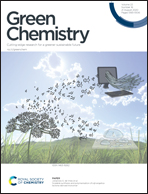Direct synthesis of phosphorotrithioites and phosphorotrithioates from white phosphorus and thiols†
Abstract
White phosphorus (P4) is still the major commercial P-atom source for the production of organophosphorus compounds. Conventionally, C–S–P bonds were constructed from environmentally questionable P(O)X directly or indirectly. From the green chemistry point of view, formation of C–S–P bonds from inorganic molecule P4 in an easy-to-operate and atom-economical way is essential because it will avoid the hazardous chlorination process. Only five methods for the formation of C–S–P bonds from P4 have been developed over the past 70 years. Here, the first general and high-yielding synthesis of P(SR)3 and P(O)(SR)3 involving P4 and thiols is presented. With the use of KOH or K2CO3 as a base and DMSO–toluene as a solvent, both arythiols and alkylthiols are tolerant in this transformation. The reaction is characterized by a complete conversion of white phosphorus. This operationally simple and environmentally sound reaction shows a broad scope of substrates and good functional group tolerance. Moreover, this method can be easily adapted to large-scale preparation.

- This article is part of the themed collection: 2020 Green Chemistry Hot Articles


 Please wait while we load your content...
Please wait while we load your content...